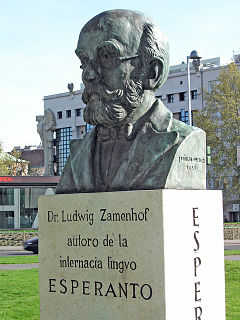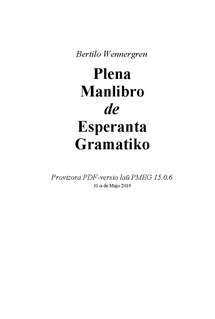
Esperanto is the world's most widely spoken constructed international auxiliary language. Created by Polish ophthalmologist L. L. Zamenhof in 1887, it was intended to be a universal second language for international communication, or "the international language". Zamenhof first described the language in Dr. Esperanto's International Language, which he published under the pseudonym "Doktoro Esperanto". Zamenhof was motivated by the broader goals of his philosophy homoranismo, for which a universal language seemed necessary. The word esperanto translates into English as "one who hopes".

Esperantujo or Esperantio is the Esperanto community; the community of speakers of the Esperanto language and their culture, as well as the places and institutions where the language is used. The term is used "as if it were a country."

L. L. Zamenhof developed Esperanto in the 1870s and '80s. Unua Libro, the first print discussion of the language, appeared in 1887. The number of Esperanto speakers have increased gradually since then, without much support from governments and international organizations. Its use has, in some instances, been outlawed or otherwise suppressed.
Esperanto culture refers to the shared cultural experience of the Esperantujo, or Esperanto-speaking community. Despite being a constructed language, Esperanto has a history dating back to the late 19th century, and shared cultural social mores have developed among its speakers. Some of these can be traced back to the initial ideas of the language's creator, Ludwig Zamenhof, including the theory that a global second language would foster international communication. Others have developed over time, as the language has allowed different national and linguistic cultures to blend together. Some researched also the ideologies of Esperanto.

L. L. Zamenhof was an ophthalmologist who lived for most of his life in Warsaw. He is best known as the creator of Esperanto, the most widely used constructed international auxiliary language.

Dr. Esperanto's International Language, commonly referred to as Unua Libro, is an 1887 book by Polish ophthalmologist L. L. Zamenhof, in which he first introduced and described the constructed language Esperanto. First published in Russian on July 26 [O.S. July 14] 1887, the publication of Unua Libro marks the formal beginning of the Esperanto movement.

Zamenhof Day, also called Esperanto Book Day, is celebrated on 15 December, the birthday of Esperanto creator L. L. Zamenhof. It is the most widely celebrated day in Esperanto culture. On this day, Esperantists hold information sessions and cultural gatherings to promote literature in Esperanto.
Esperanto is written in a Latin-script alphabet of twenty-eight letters, with upper and lower case. This is supplemented by punctuation marks and by various logograms, such as the digits 0–9, currency signs such as $ € ¥ £ ₷, and mathematical symbols. The creator of Esperanto, L. L. Zamenhof, declared a principle of "one letter, one sound", though this general guideline is not strictly followed.
Esperanto is a constructed international auxiliary language designed to have easy phonology. The creator of Esperanto, L. L. Zamenhof, described Esperanto pronunciation by comparing the sounds of Esperanto with the sounds of several major European languages.
Finvenkismo is an ideological current within the Esperanto movement dating back to L. L. Zamenhof, the initiator of Esperanto. The name is derived from the concept of a fina venko denoting the moment when Esperanto will be used as the predominant second language throughout the world. A finvenkist is thus someone who hopes for or works towards this "final victory" of Esperanto. According to some finvenkists, this "final victory" of Esperanto may help eradicate war, chauvinism and cultural oppression.

Dua Libro de l' Lingvo Internacia, usually referred to simply as Dua Libro, is an 1888 book by L. L. Zamenhof. It is the second book in which Zamenhof wrote about the constructed language Esperanto, following Unua Libro in 1887, and the first book to be written entirely in the language.
The Life of Zamenhof is a biography of L. L. Zamenhof, the founder of Esperanto, written in Esperanto by Edmond Privat. The first edition was in 1920 with 208 pages, and the second edition was in 1923 with 109 pages. Titles of the chapters in the English translation by Ralph Eliott: The Peoples of Lithuania; A Child in Bielostok; A Schoolboy in Warsaw; Student Years; Doktoro Esperanto; A Prophet of Idealism; "Homarano"; Congress Speeches; The Linguist; The Writer; The Ethical Thinker; Approach of Death. "The master, already dead, with a living spirit is among us and to be intimately acquainted with this spirit, the most humane in the last century, the faithful disciple introduces it to us through masterful eloquence in his work.". Appeared in English (1931) and Dutch (1934) translations.
Montagu Christie Butler was a British academic, librarian, lexicographer, musician, and Esperantist. A winner of several prizes at the Royal Academy of Music in London, he was a harpist and a versatile music teacher skilled in playing various musical instruments, as well as a teacher of voice and of musical composition.

Richard Henry Geoghegan was an Anglo-American philologist and the first known Esperantist from the English-speaking world. As a young man, he emigrated to the United States, first living in Washington state and then in the Alaska Territory.
The initiator of Esperanto, L. L. Zamenhof, translated the entire Hebrew Bible into Esperanto. His translation has been much admired by Esperantists and is widely held up as a model or exemplar for other Esperanto authors and translators. Other translators have also edited and published Esperanto versions of the New Testament and Apocrypha.

A Zamenhof-Esperanto object is a monument or place linked to L. L. Zamenhof, to the constructed language Esperanto that he created and first published in 1887, or to the community of Esperanto speakers which has been using the language since.

Mark Zamenhof is Esperanto form of Markus Fabianoviĉ Samenhof, "Christian" or goja name of Mordeĥaj Zamenhof, son of Fabian Zamenhof and father of L. L. Zamenhof ; teacher of languages French and German. Knight of many orders.

Plena Manlibro de Esperanta Gramatiko is a book which explains Esperanto grammar in an easy-to-learn format. It was mostly written by Bertilo Wennergren and is for ordinary Esperanto speakers who want to study Esperanto's grammar, word construction, writing and pronunciation.

The following outline is provided as an overview of and topical guide to Esperanto:

David Gaines is an American composer. He wrote the first orchestral symphony to incorporate texts written in Esperanto, and an Esperanto choral song, Povas Plori Mi Ne Plu, which concerns the former military situation in Bosnia and Herzegovina. This song won First Prize at the 1995 World Esperanto Association's Belartaj Konkursoj in Tampere. Gaines holds degrees in music composition from Northwestern University, American University, and Johns Hopkins University's Peabody Conservatory of Music.












